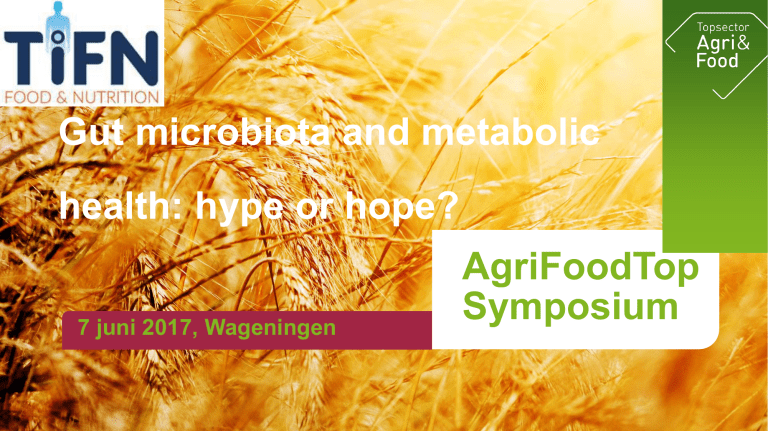
Gut microbiota and metabolic
health: hype or hope?
7 juni 2017, Wageningen
AgriFoodTop Symposium
AgriFoodTop
Symposium
Zaaien,
oogsten
en eten
De prevalentie van obesitas en type 2 diabetes mellitus neemt toe
Key facts WHO, 2015
• Worldwide obesity has more than doubled since 1980.
• 39% of adults aged 18 years and over were overweight in 2014, and 13% were
obese.
• Most of the world's population live in countries where overweight and obesity kills
more people than underweight.
• 42 million children under the age of 5 were overweight or obese in 2013.
• Obesity and related complications are preventable.
Achtergrond
• De diabesity pandemie kan niet verklaard worden door geidentificeerde
gen-omgevingsinteracties
• Gut microbiota produceren metabolieten die onze stofwisseling kunnen
beinvloeden en daarmee een rol kunnen spelen bij de regulering van
ons lichaamsgewicht en insuline gevoeligheid
• Obesitas en Type 2 diabetes mellitus zijn geassocieerd met een
veranderde samenstelling en functie van onze darmbacterieën
• Interventies die de microbiota moduleren kunnen het risico op obesitas
en type 2 diabetes mellitus beinvloeden
• Met name gebaseerd op diet experimenteel onderzoek
Relatie microbiota en gezondheid
Objective TIFN project GH003:
To provide information on the significance and mechanisms involved in
the relation between gut microbiota, energy balance and insulin sensitivity in
man, as a base for nutritional strategies in the prevention and treatment of
obesity and T2DM.
Approach:
linking ‘state-of-the art’ detailed human phenotyping and
detailed characterization of gut microbiota composition and functionality
to fill the gap between gut microbiota and human energy metabolism.
Projectopzet: Microbiota, energy balance and metabolism
Koala children cohort
Microbiota quantification
Microbiota
Complex CHO
Monosaccharides
SCFA
GPR
Human metabolic studies
-antibiotics
-SCFA administration
-feces transplantation
In vitro mechanistic deepening: adipose tissue,
muscle
GPR
Model development
Metabolism
Knowing diet-microbiota-host metabolism interactions:
strategies for optimal body weight control and
diabetes prevention: human intervention study
Vmax x2
dx1
=
dt
K m + x2
dx2
= k1 x3 - k2 x2
dt
dx3
Vmax x4
=
dt
K m + x4
Vmax x3
dx4
=
dt
K m + x3
Humane studies: Antibiotica interventie
56
40-70y
IFG/IGT
1500mg/day
7days
HOMA-IR>2.2
• wk 1 pre
• wk 2
• 2d wash out
• wk 3 post
• wk 8 follow-up
Methoden antibiotica interventie
Hyperinsulinemic clamp
Indirect calorimetry
Meal test
Adipose tissue and muscle biopsies
Gut permeability test
Feces collection
Verandering in microbiota (antibiotica) geen effecten op onze stofwisseling en
insuline gevoeligheid
Reijnders et al, Cell metabolism, 2016
Functie microbiota: productie SCFA
Acetate
Propionate
Butyrate
Centrale hypothese
Increasing colonic SCFA availability has beneficial effects on human substrate
and energy metabolism
Question:
Where to administer? Proximal vs. Distal?
Double blind, placebo controlled, randomized crossover
studies in healthy overweight males (BMI 25 – 34.9 kg/m2)
De plaats van fermentatie bepaalt de effecten op de stofwisseling
No significant effects
Circulating acetate
Fat oxidation
PYY
TNF-α
Canfora et al, Clinical Science 2016, Scientific reports 2017,
Gastroenterology, 2017
Fecal transplantation to improve insulin resistance
Baseline
Randomisation
6 weeks
Allogenic fecalTx
Allogenic fecalTx
18 weeks (e.o.s)
No intervention
N=13
Allogenic fecalTx
No intervention
No intervention
N=13
No intervention
No intervention
• 2x 24h Fecal bile acids + caloric
bomb (day -2 to -1; sitostanol)
• 2x 24h Fecal bile acids + caloric
bomb (day -2 to -1; sitostanol)
• Fat biopsy and mixed Meal Test
GLP1 (day 1)
• Fat biopsy and mixed Meal Test
GLP1 (day 1)
• Fat biopsy and mixed Meal Test
GLP1 (day 1)
• Hyperinsulinemic euglycemic
clamp (day 2)
• Hyperinsulinemic euglycemic
clamp (day 2)
• Hyperinsulinemic euglycemic
clamp (day 2)
• Small intestinal + fecal microbiota
composition + SCFA (day 3)
• Small intestinal + fecal microbiota
composition + SCFA (day 3)
• Small intestinal + fecal microbiota
composition + SCFA (day 3)
• 2x 24h Fecal bile acids + caloric
bomb (day -2 to -1; sitostanol)
Autologous fecalTx
N=12
Overall Significant Effect 1x lean donor feces after 6
weeks on peripheral insulin sensitivity in metsyn
ns
ns
Hepatic insulin sensitivity
(% suppression of EGP)
ns
100
80
60
40
20
0
t=0
t=6
autologous
t=0
t=6
allogenic
Kootte, manuscript in preparation
Highlights
• Drastische verandering van microbiota dmv antibiotica heeft geen korte of lange
termijn effect op de stofwisseling bij mensen met een verhoogd risico op diabetes
≠
• Feces transplantatie verbetert op korte termijn insuline gevoeligheid in ± 65% van
de mensen met metabool syndroom, terwijl 35 % niet reageert
• De plaats van fermentatie is een bepalende factor voor effecten op de
stofwisseling: alleen distale toediening van SCFA (acetaat) heeft effecten op
energie en substraatstofwisseling.
Zaaien,
• Dit kan belangrijke implicaties voor voedingsinterventies hebben
oogsten
• 6 proefschriften, meer dan 30 publicaties zover, leads voor vervolg en valorisatie
en eten
AgriFoodTop Symposium
Project team Microbiota, energy balance and metabolism
MUMC
AMC/UMCG
Ellen Blaak, Project Leader, 0.2 fte
Gabby Hul, Project Assistant, 0.5 fte
Kees Dejong, General Surgery
Ellen Blaak, Human Biology
Ad Masclee, Gastroenterology
Freddy Troost, Gastroenterology
Gijs Goossens, post-doc (0.25 fte)
Kaatje Lennaerts, post-doc (0.25 fte)
Dorien Reinders, PhD-student, 1 fte
Emanuel Canfora, PhD-student, 0.5 fte
Evelien Neis, PhD student, 1 fte
Kirsten Vanderbeek, PhD student, 0.5 fte
Ilja Arts, Epidemiology
John Penders, Epidemiology
Catherine Akwi Mbakwa,
Nicole Wyckmans, 0.5 fte
dietitian
WUR
Hauke Smidt
Erwin Zoetendal, Laboratory of Microbiology,
Javier Ramito Garcia,
Gerben Hermes, 0.5 fte
Bert Groen, Pediatrics, Medicine,0.1 fte
Max Nieuwdorp,, Endocrinology,
Ruud Kootte, PhD student, 1 fte
Karin v Eunen 1 fte
Aycha Bleeker 1 fte
